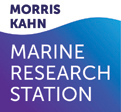
The winter aggregation of sharks near the Orot Rabin power plant is largely composed of large, female dusky sharks and smaller, male sandbar sharks. It is, therefore, possible that the female sharks are using the warmer waters of the effluent at some stage of their reproductive cycle.
In 2016, a pregnant dusky shark washed ashore near Hadera with 8 mid-stage fetuses in her uterus. Further evidence of pregnant sharks was collected via ultrasonography in 2018, which revealed 3-4 fetuses in the womb of a live dusky shark. The presence of pregnant sharks strongly indicates that mating and nursery grounds may exist along the coastline, and thus a science-based conservation and management plan is a priority for the Apex Marine Predator (AMP).
However, the hypotheses of mating and birth at Hadera are not considered, as the sharks do not display mating scars, and no observations of parturition have ever been recorded. It is also known that in other regions and species, temperature greatly influences the reproductive physiology of the animals.
Thus, the long-term increase in seawater temperature (an effect of climate change), as well as the shark’s visits to the warm water effluent near Haera stream, make this a very interesting study to undertake. The ultrasound scans are conducted in collaboration with the Tal Raz laboratory of the Hebrew University of Jerusalem, using portable underwater ultrasound.
This tool, in combination with biochemistry and endocrinology, can produce detailed results on the reproductive stage and condition of the shark and her pups.
Last year, Dr Shaked Druker of the Tal Raz Laboratory (HUJI) scanned a female shark on-board a tagging expedition. Their lab analyzed the video and concluded that one 15 cm embryo was developing in the uterus (scan image from sonogram below, picture of embryo placed above to assist with viewing the scan).





